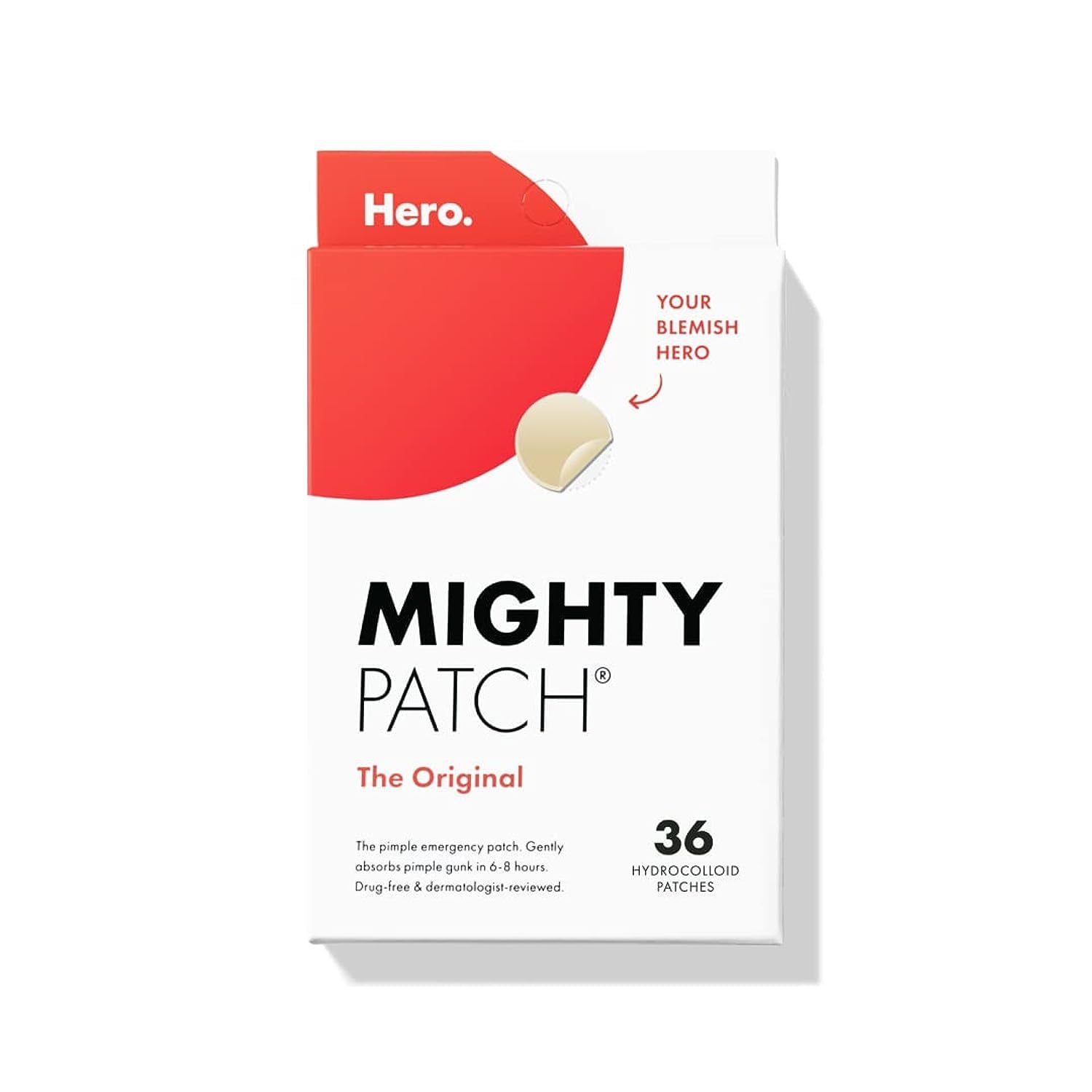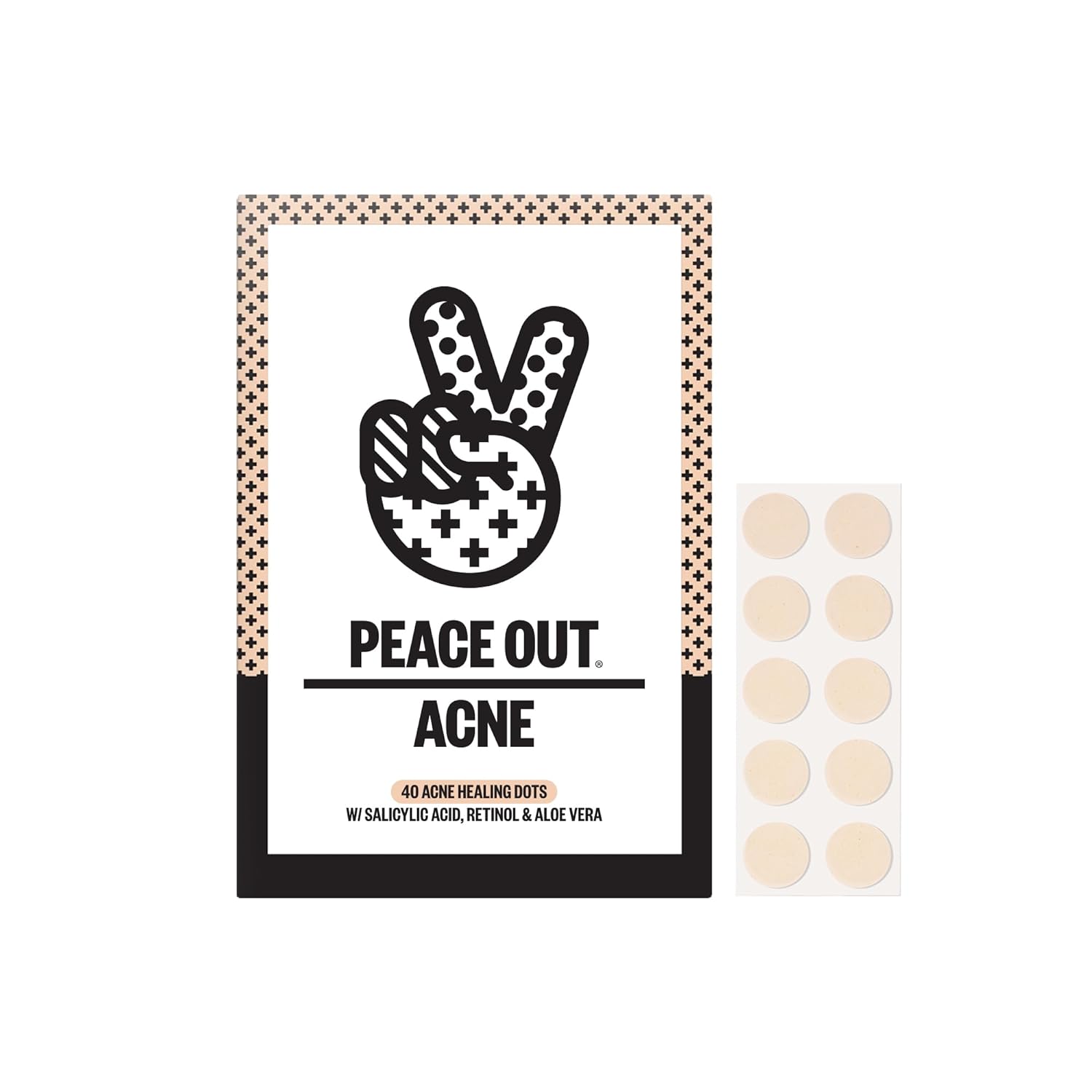I'm a participant in the Amazon Services LLC Associates Program, an affiliate advertising program designed to provide a means for me to earn fees by linking to Amazon.com and affiliated sites.
In the battle against blemishes, acne patches have become a go-to solution for many. Among the myriad of options, Mighty Patch and Peace Out stand out as leading contenders. This comprehensive comparison will delve into the features, benefits, and differences of each product to help you decide which might be the best fit for your skincare needs. Our Mighty Patch vs Peace Out review will show you which is best.
| Feature | Mighty Patch | Peace Out |
|---|---|---|
 |  | |
| Type of Acne | Best for whiteheads and surface acne | Effective on blackheads and deeper acne |
| Active Ingredients | Hydrocolloid only | Hydrocolloid + Salicylic Acid |
| Usage | Day and overnight | Preferably overnight |
| Sizes Available | Multiple sizes for targeted treatment | Standard size fits most blemishes |
| Skin Suitability | Gentle on all skin types | Best for oily and acne-prone skin |
Key Takeaways – Mighty Patch vs Peace Out
- Targeted Treatment: Mighty Patch is ideal for surface-level blemishes, whereas Peace Out offers a more aggressive treatment with the addition of salicylic acid.
- Ingredient Focus: Mighty Patch focuses on physically extracting impurities with hydrocolloid, while Peace Out combines this with chemical exfoliation.
- Versatility in Use: Both products are designed for discreet use, though Peace Out’s ingredients might be better suited for overnight use to maximize treatment efficacy.
Effectiveness and Ingredients
Mighty Patch
Mighty Patch utilizes hydrocolloid technology to absorb pus and fluids from pimples, promoting faster healing. The patches are best suited for surface-level blemishes like whiteheads. Mighty Patch is celebrated for its ability to protect blemishes from external bacteria and prevent scarring by minimizing the urge to pick at pimples (Derm Spotlight).
Peace Out
Peace Out patches combine hydrocolloid with salicylic acid, enhancing their ability to not only cover but also treat acne by exfoliating dead skin cells and reducing inflammation. This dual-action approach makes them effective for slightly more stubborn blemishes and blackheads as well (Reader’s Digest).
Application and Wear
Mighty Patch
These patches are praised for their adherence and invisibility on the skin, making them suitable for overnight use or even under makeup during the day. They come in various sizes to cover different blemish areas effectively (Reader’s Digest).
Peace Out
Similarly, Peace Out patches are designed to blend seamlessly with the skin and can be worn day or night. However, they are noted for their added treatment ingredients which may make them more suitable for wearing overnight to maximize treatment time (Reader’s Digest).
Pros and Cons – Peace Out vs Mighty Patch
Mighty Patch
Pros:
- Vegan-friendly and gentle on the skin.
- Prevents scarring by protecting blemishes.
- High customer satisfaction for efficacy in treating superficial acne.
Cons:
- Not as effective on cystic or deeper acne.
- Limited active ingredients compared to some competitors.
Peace Out
Pros:
- Includes salicylic acid for enhanced acne treatment.
- Effective on a wider range of b
Mighty Patch vs Peace Out
Pros:
- Effective on superficial types of acne like whiteheads.
- Protects from external bacteria and reduces the urge to pick at pimples.
Cons:
- Less effective on cystic acne.
- Fewer active ingredients for deep treatment.
Major Differences
The primary distinction between Mighty Patch and Peace Out lies in their formulation and target issues. Mighty Patch is primarily a hydrocolloid patch, excellent for drawing out pus from open acne like whiteheads, making it highly effective for protecting the acne from further infection and speeding up the healing process (Derm Spotlight).
On the other hand, Peace Out patches not only use hydrocolloid technology but are also infused with salicylic acid. This addition allows them to not only protect but also treat the acne by penetrating pores to clear out dead skin cells and reduce inflammation, making them suitable for more persistent blemishes and blackheads (Reader’s Digest).
For more detailed insights into skincare and how these products integrate with broader skincare routines, consider reading additional resources such as Kalade Skincare Review: Worth the Hype?, Sunday Riley vs Drunk Elephant, and The Rise of Preppy Skin Care. These articles provide further context on balancing acne treatment with overall skin health.
| Feature | Mighty Patch | Peace Out |
|---|---|---|
 |  | |
| Type of Acne | Best for whiteheads and surface acne | Effective on blackheads and deeper acne |
| Active Ingredients | Hydrocolloid only | Hydrocolloid + Salicylic Acid |
| Usage | Day and overnight | Preferably overnight |
| Sizes Available | Multiple sizes for targeted treatment | Standard size fits most blemishes |
| Skin Suitability | Gentle on all skin types | Best for oily and acne-prone skin |
Detailed Questions and Answers
1. How do hydrocolloid acne patches like Mighty Patch work?
Hydrocolloid acne patches, such as Mighty Patch, are designed to absorb pus and other impurities from pimples, facilitating a faster healing process. These patches create a moist environment that protects the affected area from bacteria and external contact, which can exacerbate the acne. The occlusive nature of the patch also prevents further irritation from environmental factors and makeup, promoting skin healing without drying out the spot.
Hydrocolloid technology originally used for wound care is effective in treating superficial acne because it draws out fluids and can help reduce inflammation. The patch forms a gel-like substance when it comes into contact with the fluid, which helps to flatten and heal the pimple more quickly than when left uncovered. This also reduces the risk of scarring as it prevents picking or touching of the pimple, which can spread bacteria and cause further inflammation.
The effectiveness of hydrocolloid patches, however, is limited to certain types of acne. They work best on pimples that have come to a head and contain pus, like whiteheads. They are not suitable for deeper, cystic acne, which might require more aggressive treatment methods such as those containing salicylic acid or benzoyl peroxide.
- Absorbs Pus: Draws out fluids from pimples.
- Protects Skin: Shields acne from bacteria and irritation.
- Limits Effectiveness: Best for superficial types of acne, not suitable for cystic acne.
2. What are the benefits of using Peace Out acne patches with salicylic acid?
Peace Out acne patches are enhanced with salicylic acid, a beta-hydroxy acid known for its ability to penetrate into the pores and dissolve the debris that causes acne. By incorporating salicylic acid, these patches not only cover the blemish but actively work to reduce it. The acid exfoliates the skin by breaking down the connections between dead skin cells, clearing the pores of oil and cellular debris, and reducing the size and redness of the pimple.
The inclusion of salicylic acid makes Peace Out patches particularly effective for treating blackheads and more stubborn forms of acne that lie deeper in the skin. The acid’s anti-inflammatory properties also help to calm the skin, reducing the overall appearance of inflammation and irritation. This dual action—physical coverage and chemical treatment—provides a comprehensive approach to acne management.
Moreover, the use of these patches can prevent the formation of new acne lesions by keeping the pores clear of excess sebum and dead skin cells. Regular use can lead to clearer skin over time, making them a useful addition to any skincare regimen aimed at controlling breakouts and maintaining clear skin.
- Salicylic Acid Benefits: Penetrates pores, reduces blemishes, and exfoliates skin.
- Treats Stubborn Acne: Effective on blackheads and deeper acne.
- Prevents New Acne: Keeps pores clear to manage breakouts.
3. How should one integrate acne patches into their skincare routine?
Integrating acne patches into a skincare routine requires consideration of both skin type and the nature of the acne being treated. For effective results, cleanse the skin thoroughly before applying the patch to ensure that no dirt, oil, or makeup remains that could prevent adhesion. After cleansing, do not apply any skincare products directly under the patch, as this could affect its effectiveness.
Acne patches should be applied to dry skin and left on for several hours, or overnight, to allow the active ingredients to work and the patch to absorb impurities. They are generally used after the application of water-based serums or treatments but before heavier creams or oils, which could interfere with the patch’s ability to stick to the skin. For patches like Peace Out that contain active ingredients, it might be beneficial to leave them on overnight to maximize their treatment time.
When removing the patch, do so gently to avoid irritating the skin. After removal, apply a gentle, non-comedogenic moisturizer to soothe the area and promote healing. Regular use of acne patches as part of an evening routine can significantly improve healing times and reduce the likelihood of scarring or further breakouts.
- Clean and Dry Skin: Ensure the area is clean before application.
- Order of Application: Apply after lightweight serums and before heavy creams.
- Gentle Removal: Remove patches carefully and moisturize afterward.
10 FAQ Questions with Brief Responses
- What types of acne are Mighty Patch and Peace Out best for?
- Mighty Patch is best for surface-level whiteheads, while Peace Out is effective on deeper blemishes and blackheads due to its salicylic acid content.
- Can acne patches be worn under makeup?
- Yes, both Mighty Patch and Peace Out can be worn under makeup due to their thin, discreet design.
- How long should you leave an acne patch on?
- It’s best to leave an acne patch on for at least several hours or overnight for maximum effectiveness.
- Are there any skin types that should avoid using acne patches?
- Those with very sensitive skin or allergies to adhesive should patch test first or consult a dermatologist.
- Can you use acne patches on cystic acne?
- Acne patches are generally not recommended for cystic acne as they do not penetrate deeply enough to treat it effectively.
- How do acne patches help prevent scarring?
- By absorbing pus and protecting the pimple from external bacteria and picking, acne patches reduce inflammation and minimize the risk of scarring.
- What is the main benefit of salicylic acid in acne patches?
- Salicylic acid helps to break down debris in pores, reduce inflammation, and promote faster healing of pimples.
- Do acne patches contain any allergens?
- While generally safe, it’s important to check the packaging for specific allergens in the adhesive or active ingredients.
- How often can you use acne patches?
- You can use acne patches as often as needed on individual blemishes, but ensure the skin is clean each time to avoid irritation.
- Are acne patches visible on the skin?
- Both Mighty Patch and Peace Out are designed to be ultra-thin and blend with the skin, making them relatively invisible especially under makeup.
For more on skincare comparisons and insights, consider reading Drunk Elephant vs Tatcha and Is Bubble Skincare Good?. These articles provide valuable information on choosing the right products for your skin type and concerns.